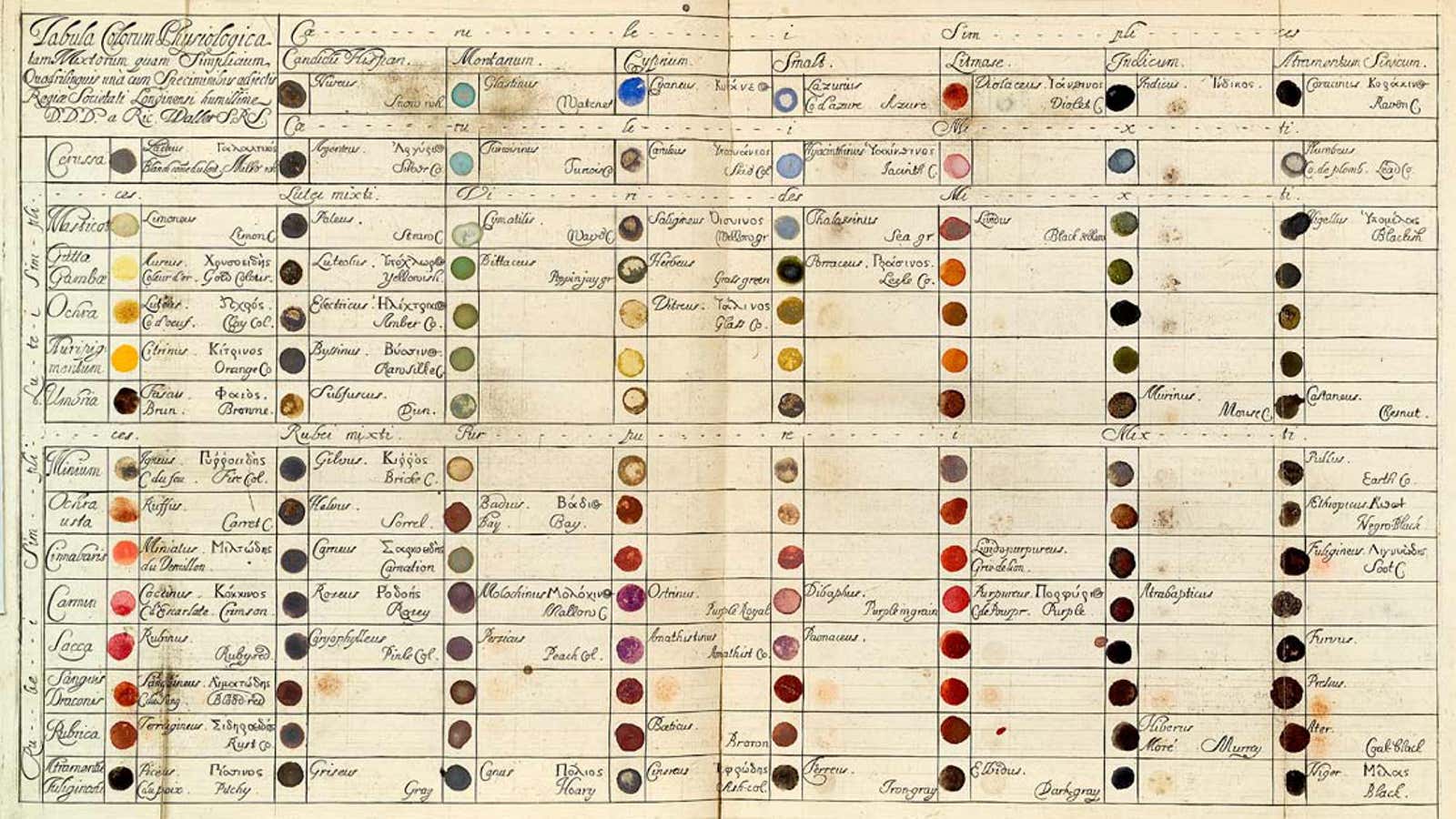Color—its chemical basis, how our minds perceive it, how one color transforms into another—has fascinated scientists and scholars for millennia. In 1664, British natural philosopher Robert Boyle tried to make sense of it with his book Experiments and Considerations Touching Colours. In “Experiment X,” he described a 17th-century scientist’s practical joke, astonishing visitors to his laboratory by asking them to wet their skin with spit and then rub silver nitrate, a white compound, on it. On his guests’ white skin, the silver nitrate instantly turned a deep, indelible black, “as if the stains had been made with Ink.”
This “joke” paved the way for Boyle’s “experiments” with skin color. Contrary to the then-common belief that the climate in which a person lived determined her skin color, Boyle saw skin color as an inherited characteristic, somewhat similar to how we see it today. But his research is a disturbing reminder that science is as capable of rationalizing corrupt forms of power as it is of guiding the way toward a more enlightened future.
Today, even as scientists increasingly understand race as a social and cultural construct—one with great power in our daily lives, but limited genetic basis—we still live in a world shaped by centuries of scientific racism. Boyle, a Royal Society member best-known for his work on the physical properties of gases, depended on slavery for his analyses of differences in skin color. The slave trade was flourishing, and the Royal African Society—an official monopoly of the British slave trade—had been founded only a few years prior.
In “Experiment XI,” Boyle puzzled over the case of Portuguese traders who were known to have children with slave women. (The British were, too, but Boyle didn’t mention them.) Boyle’s informant—an Englishman who, captured by the Portuguese, turned soldier and ship’s pilot—reported that the babies were born with lighter-toned skin, but that it would darken over a few days. It was a source of consternation and confusion for the Portuguese fathers, who would disclaim the children, though it was a thing they “greatly grieved at.”
At the time, dark skin was widely thought to be the product of more, and more intense, sun exposure; Northern Europeans were believed fair because they saw the least sun. But in his “Experiment XI,” Boyle argued that not only did individuals, white and black, retain their skin color upon transport to their new homes, but they transmitted these colors to their children, too. This was based on travelers’ narratives, correspondence with West Indian plantation owners, and discussion with physicians who had anatomized black bodies—but never with actual people of African descent.
From this partial information, Boyle constructed a troubling difference, no less between knower and the object of his knowledge than between white and black. White Britons were the knowers, capable of describing and parsing differences in external appearance and setting them in their “proper” natural and human context. Black bodies were the object of knowledge, made to speak, to tell their differences, only under the knife. This was just one element of a broader silence brutally enforced through laws that sought to prevent slaves from developing the advanced trade skills and literacy necessary to advancing economically and politically.
Through the 17th century, scholars at the Royal Society (and across Europe) debated the causes of differences in skin color. Increasingly, as Cristina Malcolmson argues, they put forward the idea that deep biological divisions separated the “races,” even to the point of suggesting that rather than there being one human family, different groups were created separately by God. Scientific explanations of human difference provided support for owners’ brutal treatment of their slaves on British sugar plantations in Jamaica and Barbados.
Boyle did not accept the idea that white skinned and black skinned people were created separately. He even pushed, though ineffectively, for legislative proposals that would ensure better treatment for slaves who converted to Christianity. But he never questioned the slave trade outright.
Indeed, connections between science and the slave trade ran deep during Boyle’s time—all the way into the account books. Royal Society accounts for the 1680s and 1690s shows semi-regular dividends paid out on the Society’s holdings in Royal African Company stock. £21 here, £21 there, once a year, once every two years. Along with membership dues and the occasional book sale, these dividends supported the Royal Society during its early years.
Boyle’s early “experiments” with the inheritance of skin color set an agenda that the scientists of the Royal Society pursued through the decades. They debated the origins of blackness with rough disregard for the humanity of enslaved persons even as they used the Royal African’s Company’s dividends to build up the Royal Society as an institution. When it came to understanding skin color, Boyle used his wealth and position to help construct a science of race that, for centuries, was used to justify the enslavement of Africans and their descendants globally. How can we—all of us, including scientists—do better?
